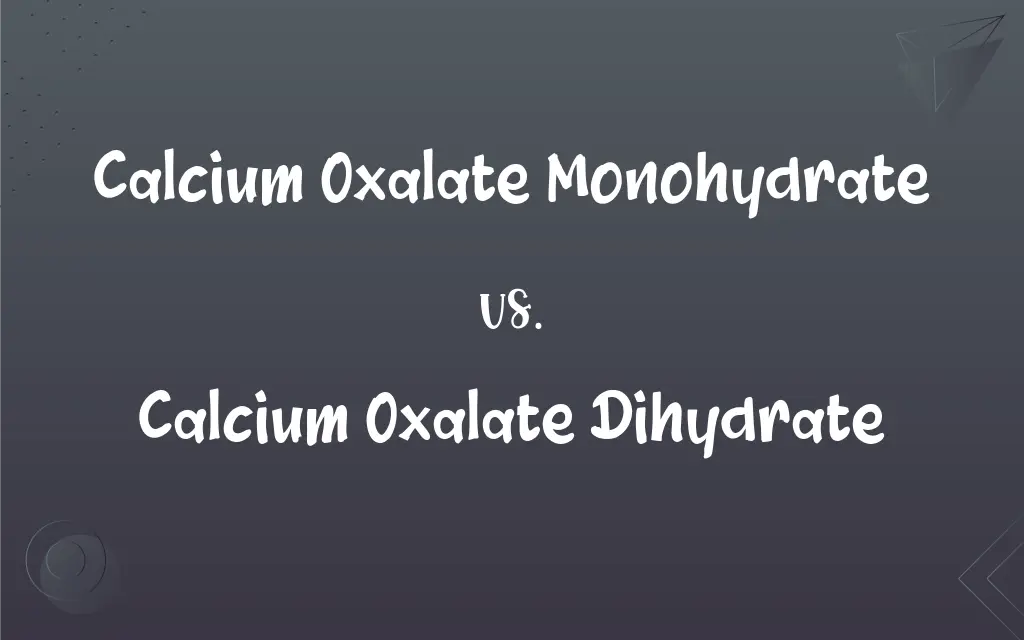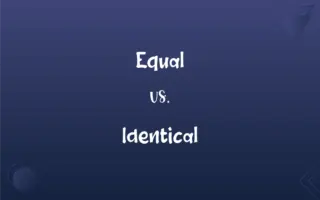Calcium Oxalate Monohydrate vs. Calcium Oxalate Dihydrate: What's the Difference?
Edited by Aimie Carlson || By Janet White || Published on January 12, 2024
Calcium oxalate monohydrate (COM) contains one water molecule, forming harder crystals, while calcium oxalate dihydrate (COD) has two, resulting in softer, more fragile crystals.

Key Differences
Calcium oxalate monohydrate (COM) is a chemical compound characterized by having one water molecule bound to each calcium oxalate unit. In contrast, calcium oxalate dihydrate (COD) has two water molecules associated with each unit. This difference in hydration levels significantly impacts their physical properties.
In terms of crystal structure, COM forms denser and harder crystals. This is due to the tighter molecular structure afforded by having only one water molecule. Conversely, COD, with its two water molecules, tends to form larger, less dense crystals, which are generally softer compared to COM.
COM is often more stable at higher temperatures than COD. This stability is attributed to its lower water content, requiring higher energy to break down its structure. In contrast, COD, with its higher water content, is less stable and can transition to COM under certain conditions.
The formation of COM is typically associated with more severe conditions in biological systems, like kidney stones, due to its hardness and compact structure. COD, while also found in kidney stones, is generally associated with less aggressive forms due to its softer nature.
In terms of solubility, COM is less soluble in water compared to COD. This reduced solubility is due to its more compact structure, making it more difficult for water molecules to interact and dissolve the compound.
ADVERTISEMENT
Comparison Chart
Water Molecules
One water molecule per unit
Two water molecules per unit
Crystal Hardness
Harder and denser crystals
Softer and less dense crystals
Thermal Stability
More stable at higher temperatures
Less stable, transitions to COM
Biological Implications
Associated with severe conditions
Linked to less aggressive forms
Solubility
Less soluble in water
More soluble in water
ADVERTISEMENT
Calcium Oxalate Monohydrate and Calcium Oxalate Dihydrate Definitions
Calcium Oxalate Monohydrate
A variant of calcium oxalate frequently found in kidney stones.
Calcium oxalate monohydrate is often identified in the analysis of extracted kidney stones.
Calcium Oxalate Dihydrate
A crystalline compound with two water molecules.
The presence of calcium oxalate dihydrate was confirmed through its distinct crystal structure.
Calcium Oxalate Monohydrate
A stable form of calcium oxalate at higher temperatures.
Calcium oxalate monohydrate remained intact even after increasing the temperature during the experiment.
Calcium Oxalate Dihydrate
Known for forming softer, larger crystals.
Under the microscope, the calcium oxalate dihydrate crystals appeared softer and larger than expected.
Calcium Oxalate Monohydrate
A less soluble form of calcium oxalate.
Calcium oxalate monohydrate's low solubility makes it a common component in certain types of kidney stones.
Calcium Oxalate Dihydrate
A more soluble form of calcium oxalate.
In our solubility tests, calcium oxalate dihydrate dissolved more readily than its monohydrate counterpart.
Calcium Oxalate Monohydrate
A compound known for its hard and dense crystal structure.
The calcium oxalate monohydrate crystals in the sample were noticeably harder than other forms.
Calcium Oxalate Dihydrate
Transforms into monohydrate under certain conditions.
During the experiment, we observed calcium oxalate dihydrate transitioning into monohydrate form.
Calcium Oxalate Monohydrate
A crystalline compound with one water molecule.
In the lab, we observed the formation of calcium oxalate monohydrate crystals under the microscope.
Calcium Oxalate Dihydrate
A less severe form of calcium oxalate in biological systems.
Calcium oxalate dihydrate is typically associated with milder kidney stone conditions.
FAQs
What distinguishes calcium oxalate dihydrate?
It has two water molecules per calcium oxalate unit.
What is calcium oxalate monohydrate?
A chemical compound with one water molecule per unit of calcium oxalate.
Can COD transform into COM?
Yes, under certain conditions, COD can become COM.
Are COM and COD found naturally?
Yes, both are naturally occurring, especially in biological systems.
Which is harder, COM or COD?
COM is harder and denser than COD.
How do temperature changes affect COM and COD?
COM is more thermally stable, while COD is less stable and can transition to COM.
Which is more common in kidney stones?
COM is more commonly found in kidney stones.
Is COD more soluble than COM?
Yes, COD is more soluble in water.
What is the significance of COM in kidney stones?
COM is often associated with more severe kidney stone conditions.
Does COD have biological implications?
Yes, it's associated with less severe forms of kidney stones.
Does the presence of COM indicate a health issue?
Its presence, especially in kidney stones, can indicate health concerns.
How do COM and COD affect water filtration systems?
They can contribute to scale and clog filtration systems.
What role does water content play in COM and COD?
It affects their crystal structure, stability, and solubility.
Can COD be artificially created?
Yes, both forms can be synthesized in the lab.
Can COM and COD be dissolved using chemicals?
Certain chemicals can dissolve them, depending on the application.
Are COM and COD visible to the naked eye?
Usually not; they require microscopic examination.
Are there treatments for COM and COD kidney stones?
Treatments include hydration, medication, and sometimes surgery.
Is there a genetic predisposition to forming COM or COD stones?
Genetics can play a role, along with dietary and environmental factors.
How are COM and COD diagnosed?
Through crystallographic and chemical analysis.
Can diet influence the formation of COM and COD?
Yes, dietary factors can impact their formation in the body.
About Author
Written by
Janet WhiteJanet White has been an esteemed writer and blogger for Difference Wiki. Holding a Master's degree in Science and Medical Journalism from the prestigious Boston University, she has consistently demonstrated her expertise and passion for her field. When she's not immersed in her work, Janet relishes her time exercising, delving into a good book, and cherishing moments with friends and family.
Edited by
Aimie CarlsonAimie Carlson, holding a master's degree in English literature, is a fervent English language enthusiast. She lends her writing talents to Difference Wiki, a prominent website that specializes in comparisons, offering readers insightful analyses that both captivate and inform.

































































